***************************
Published in the New York Law Journal 9/8/2008
United States v. Steven Coren, 07-CR-265 - Decided: August 29, 2008; District Judge Eric N. Vitaliano
U.S. DISTRICT COURT EASTERN DISTRICT OF NEW YORK
Appearances: For US: Richard T. Faughnan, United States Attorneys Office Eastern District of New York, Brooklyn, NY; Sarah Mary Coyne, United States Attorneys Office, Eastern District of New York, Brooklyn, NY; For Defendant: Lawrence H. Schoenbach, New York, NY, Marc Lee Mukasey, Bracewell & Giuliani LLP, New York, NY, Judge Vitaliano
MEMORANDUM AND ORDER
Defendant Steven Coren moves to dismiss criminal charges brought against him in a 17 count indictment filed on April 4, 2007. For purposes of the motion the factual allegations are deemed true and, following extensive briefing including by amici, the motion is denied.
Background
The indictment charges, in substance, that Coren, an attorney, devised for clients schemes to defraud various government entities relating to construction contracts subject to the Davis-Bacon Act, Title 40, U.S.C. §3142 ("Davis-Bacon") or New York Labor Law Section 220, et seq. ("Section 220" or "Little Davis-Bacon"), by creating the false appearance that laborers working for the contractors were being paid the required prevailing wage. Specifically, counts one through ten charge Coren with mail fraud, in violation of 18 U.S.C. §§1341 and 2; counts 11 through 13 charge Coren with wire fraud, in violation of 18 U.S.C. §§1342 and 2; and counts 14 through 16 charge Coren with money laundering and money laundering conspiracy, in violation of 18 U.S.C. §§1956(1)(3)(B) and 1956(h), respectively. Count 17 charges Coren with obstruction of justice in violation of 18 U.S.C. §1512(c)(1) through the altering or concealing of records with the intent to impair their integrity and availability for use in an official proceeding.
Applicable Statutes
Davis-Bacon requires that contracts in excess of $2,000 to which the United States is a party for the construction, alteration, or repair of public buildings or public works contain a provision "stating the minimum wages to be paid various classes of laborers and mechanics." 40 U.S.C. §3142(a). The minimum wages to be paid are the wages that the Secretary of Labor determines to be "prevailing" for laborers and mechanics employed on similar projects in the same geographical area in which the work is to be performed (the "prevailing wage"). 40 U.S.C. §3142(b). As set by the statute, the prevailing wage has two components, both of which are computed on an hourly basis: a basic rate of pay and a fringe benefit amount.1 A contractor may discharge its prevailing wage fringe benefit obligations by either: (1) paying in cash; (2) making contributions to a trustee or to a third person pursuant to a fund, plan, or program referred to in 42 U.S.C. §3141(2)(B)(i); (3) assuming an enforceable commitment to bear the costs of a plan or program referred to in 42 U.S.C. §3141(2)(B)(ii); or (4) by a combination thereof. 40 U.S.C. §3142(d).
New York's Little Davis-Bacon Act contains essentially the same provisions as the federal prevailing wage law. Pursuant to this statute, each contract, to which the state, a locality, a public benefit corporation, or a commission appointed by law is a party, for the construction, alteration, or repair of a public works project must contain a provision requiring that laborers, workmen and mechanics be paid not less than the prevailing wage, to be determined by either the New York State Department of Labor, or the New York City Comptroller if the work is performed for agencies of the City of New York. As with Davis-Bacon, under Section 220, the prevailing wage consists both of a basic hourly rate and supplemental benefit rate. "Supplements", as defined by the statute, mean "all remunerations for employment paid in any medium other than cash . . . or any payments which are not 'wages' . . . including, but not limited to, health, welfare, non-occupational disability, retirement, vacation benefits, holiday pay, life insurance, and apprenticeship training." Section 220(5).2
Davis-Bacon and Little Davis-Bacon each requires contractors, on a regular basis, to submit a transcript of their payroll to a public agency and to certify under the penalties of perjury that they complied with the prevailing wage requirements. See 29 C.F.R. §5.5(a)(3); Hopkins v. Unites States Dep't of Hous. & Urban Dev., 929 F.2d 81, 86 (2d Cir. 1991) ("To demonstrate compliance with wage standards, federal contractors are required to submit weekly certified statements with respect to the wages paid each affected employee."); Section 220(3-a)(a)(iii). Credit is given for compliance when the contractor has met the obligations as to both the hourly wage and the fringe benefit wage.
Relevant Facts
Coren, during the relevant time, practiced out of the Manhattan offices of his law firm, Coren & Associates, P.C. As part of his practice, Coren advised several contractor clients. In connection with this work, in 1993, Coren established the Contractor's Benefit Trust (the "CBT"), an entity formed under the dual authority of ERISA and the IRS Code. As stated in its Declaration of Trust, the CBT was created "to provide benefits under New York State Labor Law Section 220 (and other similar state laws in other states), the Davis-Bacon Act, or any other state or federal rule requiring the payment of prevailing supplemental benefits which include pension annuity, vacation, health and welfare, or like benefits." As devised by Coren, client-contractors who participated in the CBT would make prevailing wage fringe benefit payments to the trust as irrevocable contributions to a trustee or a third person under a fund, plan, or program. The CBT then served as a "benefits bank", funding various types of employee welfare benefits, including health, vacation, and the like to certain eligible employees. Companies utilizing the CBT signed a Participation Agreement, by which the employer designated the specific benefits plan(s) it wanted to provide its employees. Coren was the trustee of the CBT.
Contributions to the CBT were expressly limited to those funds necessary to cover fringe benefits required to be paid to workers under the provisions of a state and/or federal prevailing wage law. Further, absent written permission from the trustee (Coren), contributions were permitted only if the employer actually received credit for the contribution in satisfaction of its obligation to provide such prevailing wage benefits. Consequently, the monies held in the CBT consisted solely of contributions that Coren's client-contractors had certified to state and/or federal agencies satisfied their obligation to pay prevailing wage fringe benefits owed by law to prevailing wage employees.
As charged in the indictment, Coren knew, and, in fact, intended, that employer contributions to the CBT would not be used exclusively to provide fringe benefits to the prevailing wage employees on whose behalf credit had been claimed by his client-contractors. Rather, the funds in the CBT were used for the purchase of welfare benefits for company employees without regard to the type of work performed by that employee. In some instances, the benefits paid by the CBT inured solely, or, at least, mostly, to the benefit of the owners and operators of the companies themselves. Coren, it is therefore alleged, advised, counseled and assisted his client-contractors in using the CBT to claim fraudulently to state and federal agencies that they were in full compliance with their prevailing wage obligations, even though a significant portion of the funds contributed to the CBT were not used to provide fringe benefits for the workers on whose behalf the contribution had been made and prevailing wage credit received. Put simply, the indictment's essential criminal theme is that Coren assisted these owners and operators in diverting funds deposited on behalf of prevailing wage workers, and reported to state and federal agencies as satisfying prevailing wage obligations, back into their own pockets. Correspondingly, under Coren's alleged scheme, employees working on government projects received wages below the prevailing wage, despite the employer's contrary sworn certification.
The fraudulent schemes allegedly contrived by Coren were described with some detail in the indictment:
Fraudulent Scheme 1: In 2000, Coren established a CBT account for two door manufacturing and installation companies, known as Corporation-1 and Corporation-2, both of which were owned and operated by Cooperating Witness 1 (CW-1) and Cooperating Witness 2 (CW-2). These corporations performed work primarily on publicly funded projects subject to prevailing wage obligations. Coren advised and counseled CW-1 and CW-2 to deposit funds into the CBT that they would claim as fringe benefit contributions in satisfaction of their prevailing wage obligations. Coren then further advised CW-1 and CW-2 to use those deposits to purchase benefits, such as health insurance, for nonprevailing wage employees of the corporations on whose behalf the contributions to the CBT had not been made. The indictment further charges that Coren advised, counseled and assisted CW-1 and CW-2 in setting up a vacation trust that maintained eligibility requirements which essentially precluded all employees from receiving any vacation and holiday benefit, except for CW-1 and CW-2, who were themselves nonprevailing wage employees.
Fraudulent Scheme 2: On or about August 2003, Coren established a CBT account for Corporation 3. Corporation 3 was partly owned by Cooperating Witness 3 (CW-3). Cooperating Witness 4 (CW-4) was employed by CW-3 as the office manager. Coren allegedly advised, counseled and assisted CW-3 and CW-4 in establishing a CBT account into which Corporation-3 would deposit funds claimed as fringe benefit contributions in satisfaction of prevailing wage obligations. As with the previous scheme, the indictment claims Coren advised CW-3 and CW-4 to use those CBT deposits to purchase benefits for nonprevailing wage employees on whose behalf fringe benefit contributions had not been made. Coren also advised and counseled CW-3 and CW-4, it is charged, to deposit funds into the CBT account for one specified group of prevailing wage workers and then transfer some or all of the funds in that account to various labor union benefit funds on behalf of a separate group of prevailing wage workers, for whom Corporation 3 also claimed to have satisfied its fringe benefit obligations. Thus, the indictment charges, on the advice and with the assistance of Coren, Corporation-3 took credit for having paid the fringe benefit portion of the prevailing wage for two groups of workers, while actually depositing money on behalf of only one group.
As one would expect, the obstruction of justice count relates to the investigation which precipitated the principal counts of the indictment. To that end, count 17 references the work of a grand jury in the Eastern District of New York, duly empanelled in November 2005, that was investigating one of the fraudulent schemes charged in this indictment. Thereafter, on or about January 12, 2006, Coren was informed by a cooperating witness that his company was under investigation by a law enforcement agency and that law enforcement officials had obtained certified payrolls submitted by the corporation for work it performed as a subcontractor on various state and federal projects. Coren, in response, allegedly advised the owners and operators of the company, with whom he had previously dealt, to conceal and destroy records, documents and other objects relating to the transfer of CBT funds.
Rule of Decision
Federal Rule of Criminal Procedure 12(b)(2) permits a criminal defendant to raise by pretrial motion "any defense, objection, or request that the court can determine without a trial of the general issue." A court faced with a motion to dismiss must ask, first, whether the indictment states an offense, and second, whether the indictment is sufficiently specific to provide notice and allow the defendant to plead double jeopardy in a subsequent case. See United States v. Sierra-Garcia, 760 F. Supp. 252, 258 (E.D.N.Y. 1991). Allegations of fact in the indictment must be accepted as true and contrary assertions of fact by the defendant will not be considered. United States v. Goldberg, 756 F.2d 949, 950 (2d Cir. 1985).
Discussion
Coren primarily advances three arguments in support of his motion to dismiss. First, that the indictment does not charge a crime because Coren's client-contractors fully complied with Davis-Bacon and Section 220 by claiming credit for funds deposited into the CBT. Second, that, to the extent Davis-Bacon and Little Davis-Bacon require anything more than a contribution to a fund, such as the CBT, the statute fails to provide adequate notice of the prohibited conduct. Finally, that, even assuming, arguendo, the client-contractors were in violation of applicable prevailing wage laws, Coren cannot be criminally liable because he did not advise his clients as to the amount of credit they could properly claim.
ERISA and Prevailing Wage Law
The heart of Coren's motion to dismiss focuses on the intersection of ERISA and the prevailing wage laws. According to Coren, because ERISA controls the operation of a benefit trust, such as the CBT, prevailing wage laws can require only that employers who are subject to prevailing wage requirements contribute a defined amount to an ERISA-qualified benefits trust, but cannot, in any way, dictate how those funds are then distributed. Coren thus contends that an employer can properly claim prevailing wage credit for contributions to a trust in the name of prevailing wage workers, regardless of whether and how those contributions relate to benefits ultimately provided (or not provided) to those workers. Furthermore, Coren points out, ERISA precludes discrimination by employers among employees who are "qualified" to receive benefits - as defined by a plan or program - and that, under ERISA, employees have no ownership interest or specific right to any asset in such a fund. Coren also notes that ERISA preempts state law, such that state prevailing wage laws cannot (1) prescribe either the type and/or the amount of an employer's contribution to a plan, rules or (2) promulgate regulations under which a plan operates, or (3) dictate the nature or amount of benefits provided under the plan. For these reasons, Coren argues that contributing to a trust alone must satisfy prevailing wage obligations, even if those contributions do not relate, in any way, to benefits ultimately provided to prevailing wage workers:
For government prevailing wage reporting purposes, if the benefits wages are contributed to a proper ERISA trust, the contractor has met his obligation under Davis-Bacon. Once the benefits have been deposited, the specific rules governing the ERISA plan take effect and define acceptable uses of the funds such as non-discriminatory benefit payments on behalf of plan participants pursuant to the employer's plan.
(Def's Br. at 10.) Since, as it is alleged in the indictment, Coren's client-contractors did contribute money to a qualified ERISA trust, and both Coren and his clients were in full compliance with ERISA, Coren contends that the indictment fails to state a crime.
The government conceded at oral argument there is no allegation that the CBT, and Coren as trustee of the CBT, failed to comply with ERISA. But, it is more of a demurrer than a concession for the government argues that compliance with ERISA is irrelevant to the question of whether Coren and his client-contractors criminally violated prevailing wage laws. According to the government, prevailing wage laws require that there be a reasonable relationship between contributions to a trust on behalf of prevailing wage workers and benefits actually received by those workers in order for an employer to properly claim credit. Whether the employer complies with ERISA in the operation of the trust is irrelevant, the government says, to the question of whether the employer properly claimed credit under prevailing wage laws. Coren argues that the government's position is untenable, because ERISA controls plan benefit payments to workers, and, under ERISA, an employee has no ownership interest or other specific rights; "no member of a defined benefit plan under ERISA has a claim to any particular asset that composes a part of the plan's general asset pool." (Def's Br. at 15 (citing Hughes Aircraft Co. v. Jacobson, 525 U.S. 432, 440 (1999).)
Coren's argument, though provocative, is fatally flawed. First and foremost, nothing in the prevailing wage laws requires the payment of supplemental benefits through an ERISA-qualified trust. The laws simply require that they be paid. They could, of course, always have been paid in cash. Therefore, whatever an employer's obligations are under Davis-Bacon, they are not discharged solely because dollars claimed to satisfy payment of a prevailing supplement wage obligation are in fact contributed to an ERISA qualified-fund, plan or program; nor is the government precluded from examining who the actual beneficiaries of the CBT were in order to determine compliance with prevailing wage laws. ERISA and Davis-Bacon need not work at cross purposes, and when an employer chooses to utilize an ERISA-qualified trust to satisfy its Davis-Bacon obligation, compliance must be had with both.
Moreover, the relationship between prevailing wage laws and ERISA is not one of first impression in this Circuit. In HMI Mech. Sys., Inc. v. McGowan, 266 F.3d 142 (2d Cir. 2001), the court of appeals addressed the intersection of ERISA and Section 220. In that case, an employer challenged New York's labor regulations, which determined a contractor's compliance with Section 220 by using, among other things, an annualization formula.3 Id. at 145. To enforce Section 220, the state required that HMI, the plaintiff-employer, submit internal allocations of benefits to determine the adequacy of benefits distributed under its plan. Id. at 146. In particular, the state had subpoenaed documents and records "which look[ed] to the effect of pooling plan contributions to benefit not only public workers but also private workers or public workers on private projects." Id. at 150. "[T]he subpoenas sought to uncover whether employers were diminishing the prevailing wage protections for public projects by spreading the benefits over hours worked on private projects." Id.
The plaintiff in that case had chosen to satisfy its fringe benefit obligations by contributing to a pooled ERISA trust4, similar to the CBT. There, as here, the plaintiff claimed that the state's inquiry under Section 220 improperly focused on the internal allocation and adequacy of benefits provided by the trust, an examination that plaintiff argued was preempted by ERISA. The Second Circuit rejected this argument, holding that the state's method of enforcement only indirectly affected ERISA plans. Id. at 151. Specifically, the Circuit held that the state was not mandating a particular structure for ERISA plans, did not require plans to exclude participants who performed work on private projects, and did not mandate a particular method of administrating the ERISA plan. Id. To the contrary, employers remained free to satisfy their prevailing wage obligations through any combination of contributions to ERISA plans, contributions to non-ERISA plans, or cash payments. Id. In fact, even noting that New York's enforcement methods eliminated incentives for employers to pool supplement contributions among public and private workers, the court held that "ERISA does not preempt a law that uses economic incentives in this way. Id. (citing California Div. of Labor Standards Enforcement v. Dillingham Constr., N.A., Inc., 519 U.S. 316, 32 (1997)). See also Burgio & Campofelice, Inc. v. New York State Dep't of Labor, 107 F.3d 1000, 1009 (2d Cir. 1997) (holding, in relation to Section 220, "[w]here a legal requirement may be easily satisfied through means unconnected to ERISA plans, and only relates to ERISA plans at the election of an employer, it affects employee benefit plans in too tenuous, remote, or peripheral a manner to warrant a finding that the law 'relates to' the plan"); Minnesota Chapter of Associated Builders & Contractors, Inc. v. Minnesota Dep't of Labor & Indus., 47 F.3d 975 (8th Cir. 1995) (prevailing wage law not preempted by ERISA where it did not require employer to provide any level of benefit and only affected benefit plans to the extent that the employer chose to include benefits as part of the wage); Keystone Chapter, Associated Builders & Contractors, Inc. v. Foley, 37 F.3d 945 (3d Cir. 1994) (ERISA did not preempt state prevailing wage law where the law did not single out ERISA plans for special treatment or even refer to such plans, and in the absence of ERISA, the wage law could be meaningfully applied).
That is the case here as well. There is no essential conflict between ERISA and the government's enforcement of the prevailing wage laws. The indictment does not, as Coren contends, suggest that the structure of the CBT is illegal, or that, standing alone, the use of a trust, like the CBT, to pay benefits to nonprevailing wage workers violates prevailing wage laws. Rather, the indictment charges that, on the advice, counsel and with the assistance of Coren, Coren's client-contractors defrauded government agencies by falsely claiming credit for paying their public workers the prevailing wage for work performed on public contracts. The CBT is only relevant to the extent that it was developed by Coren as part of the alleged scheme to defraud those agencies into giving prevailing wage credit, and thus awarding construction contracts, to his clients, who would fail to pay the prevailing wage. Had Coren's contractor-clients used the CBT in the manner alleged as a pooled trust, i.e., accepting only contributions from prevailing wage workers while providing benefits to nonprevailing wage workers and prevailing wage workers alike, but adjusted the amount of prevailing wage credit they claimed accordingly, there would be no fraud, and, consequently, no crime. It is, however, the contractors' alleged use of the CBT, on the advice and counsel of Coren, to give the appearance to government agencies that the employers were paying prevailing wages, while instead effectively using the money to pay other expenses, such as benefits for nonprevailing wage workers, that makes out the crimes charged. Stated differently, the mediacy of an ERISA-qualified trust to accomplish this illegal objective and full compliance with ERISA provide no safe harbor. See HMI, 266 F.3d at 151.
Indeed, Coren himself acknowledged the proper interplay of ERISA and the prevailing wage laws in his reply memorandum of law at pages 4-5:
[The government] goes to great pains to argue that ERISA does not pre-empt all state prevailing wage laws. This is true only to the extent that the prevailing wage law does not impact upon the operation or administration of an ERISA plan. State governments are free to determine how much credit to give ERISA plan contributions for purposes of their prevailing wage laws without implicating ERISA pre-emption. Similarly, the federal government routinely enforces Davis-Bacon by restricting the amount of credit it permits an employer to take for contributions to a benefit plan. If the contributions or benefits under that plan do not qualify for Davis-Bacon credit, the employer is not entitled to credit, and must comply with Davis-Bacon in some other fashion. This is the only way to reconcile the requirements of Davis-Bacon and ERISA.
Precisely.
Due Process
Coren argues, in the alternative, that the indictment should be dismissed on the ground that, as applied, the statute is unconstitutionally vague. Of course, fundamental principles of constitutional fair warning mandate "that no individual be forced to speculate, at peril of indictment, whether his conduct is prohibited." Dunn v. United States, 442 U.S. 100, 112 (1979). One manifestation of that principle is the void-for-vagueness doctrine, which "requires that a penal statute define the criminal offense with sufficient definiteness that ordinary people can understand what conduct is prohibited and in a manner that does not encourage arbitrary and discriminatory enforcement." Kolender v. Lawson, 461 U.S. 352, 357 (1983); see also United States v. Dauray, 215 F.3d 257, 264 (2d Cir. 2000) ("Due process requires that a criminal statute 'give fair warning of the conduct that it makes a crime.'" (quoting Bouie v. City of Columbia, 378 U.S. 347, 350-51 (1964))). "The touchstone inquiry is 'whether the statute, either standing alone or as construed, made it reasonably clear at the relevant time that the defendant's conduct was criminal.'" United States v. Velastegui, 199 F.3d 590, 593 (2d Cir. 1999) (quoting United States v. Lanier, 520 U.S. 259, 266 (2005)).
The rule of lenity, another manifestation of the principle of due process, "ensures fair warning by so resolving ambiguity in a criminal statute as to apply it only to conduct clearly covered . . . . [A]lthough clarity at the requisite level may be supplied by judicial gloss on an otherwise uncertain statute, due process bars courts from applying a novel construction of a criminal statute to conduct that neither the statute nor any prior judicial decision has fairly disclosed to be within its scope." Lanier, 520 U.S. at 266 (internal citations omitted). "Because the meaning of language is inherently contextual," however, the Supreme Court has "declined to deem a statute 'ambiguous' for purposes of lenity merely because it was possible to articulate a construction more narrow than that urged by the Government." Moskal v. United States, 498 U.S. 103, 108 (1990) (emphasis in original). The rule "applies only when, after consulting traditional canons of statutory construction, we are left with an ambiguous statute." United States v. Shabani, 513 U.S. 10, 17 (1994). Where such an ambiguity does exist, the rule of lenity requires that "a court should resolve [the] ambiguity in favor of the defendant." United States v. Polizzi, 549 F. Supp. 2d 308, 377 (E.D.N.Y. 2008).5 Finally, it is well established that vagueness challenges other than in the First Amendment context "must be examined in light of the facts of the case, on an as-applied basis." United States v. Whittaker, 999 F.2d 38, 42 (2d Cir. 1993) (quotation omitted); see also United States v. Mazurie, 419 U.S. 544, 550 (1997).
Here, Coren does not argue that the mail and wire fraud statutes are themselves unconstitutionally vague. Rather, Coren contends that, as applied to this case, the mail and wire fraud charges incorporate provisions from Davis-Bacon and Little Davis-Bacon which lack the precision of criminal code. Specifically, Coren claims that the prevailing wage statutes' lack of guidance on the necessary relationship between funds deposited into a trust account, such as the CBT, and benefits paid from the account in order to claim prevailing wage credit, preclude the imposition of criminal liability. The government responds that this is not a case about unintentional misunderstandings regarding the necessary relationship between deposits to and benefits from the CBT. Rather, it notes, Coren is charged with devising a scheme to intentionally falsify credits to state and federal agencies by establishing the CBT and advising his client-contractors to use the CBT to give the appearance of compliance with prevailing wage obligations. Moreover, the government urges that the relevant prevailing wage laws are neither uncertain nor complex, and that no contractor or attorney would miscomprehend that full prevailing wage credits could not be taken knowing that the money owed in supplemental wages would not be used to benefit the workers entitled to them.
This branch of Coren's motion fails as well. The mail and wire fraud statutes, as applied to the facts alleged in the indictment, are not unconstitutionally vague. Specifically, the mail fraud statute requires the government to show that a defendant devised a scheme to defraud the alleged victim of money, and used the mail to execute the scheme. The wire fraud statute requires the same for schemes in which the wire is used. Though Coren is correct that, at least to the Court's knowledge, this is the first criminal case of its kind, but for every kind of crime there is always an inaugural charge. What is critical and dispositive here is the abundance of authority which patently establishes that the conduct alleged in this inaugural charge is prohibited. The relevant prevailing wage laws, the regulations implementing those laws, as well as caselaw all make clear that, in order to take credit for payments to prevailing wage workers, there must be, at a minimum, a reasonable relationship between the credit taken and the benefit received by the prevailing wage workers for whom the credit is taken.
As an initial matter, the texts of Davis-Bacon and Section 220 make plain that contributions to a trust, for which prevailing wage credit is claimed, must be related to a benefit received by the prevailing wage worker for their work on public projects. As we have seen, prevailing supplement wages may be paid to worker beneficiaries in a number of ways, including through an ERISA-qualified trust, but "all supplements due under [the prevailing wage laws] shall be paid to or on behalf of an employee." See Section 220(3)(e) (emphasis added). And, to that end, employers working on prevailing wage projects must submit a statement of compliance, certifying "[t]hat each laborer or mechanic has been paid not less than the applicable wage rates and fringe benefits or cash equivalents for the classification of work performed." 29 C.F.R. 5.5(a)(3) (emphasis added). Beyond quibble, any reasonable reading of the statutes informs an employer that it may only claim prevailing wage credit for contributions to a trust where there is a nexus between the payment made and a benefit to be actually received by the worker or class of workers on whose behalf prevailing wage credit is taken. Cf., Velastegui, 199 F.3d at 593.
Indeed, legislative history and interpretive caselaw further illuminate this requirement. As the Supreme Court has noted, the primary purpose of such prevailing wage laws is to protect construction workers "from substandard earnings by fixing a floor under wages on Government projects." Walsh v. E.A. Schlecht, 429 U.S. 401, 411 (1977) (quoting United States v. Binghamton Constr. Co., 347 U.S. 171, 176-77 (1954)); see Beltron Constr. Co. v. McGowan, 260 A.D.2d 870, 871-72, 688 N.Y.S.2d 783,785 (3d Dep't 1999) ("Labor Law §220 was enacted to ensure that employees on public works projects are paid wages equivalent to the prevailing rate of similarly employed workers in the locality where the contract is to be performed.") see also Chesterfield Assoc. v. New York States Dep't of Labor, 4 N.Y.3d 597, 830 N.E.2d 287, 797 N.Y.S.2d 389 (2005) (holding that prevailing wage laws also serve to level the playing field among contractors and to prevent underbidding). Clearly, it is the intent of Davis-Bacon to "restrict severely the occasions when prevailing wages may be returned to contractors and to prohibit the use of deductions from employee wages to profit or benefit contractors." Int'l Brotherhood of Electrical Workers, Local 357, AFL-CIO v. Brock, 68 F.3d 1194, 1201 (9th Cir. 1995). Further, it matters not whether hourly wages or supplement wages are in issue; the fringe benefits provided for in the Act "constitute an integral part" of an employee's wage. S. Rep. No. 963, 88th Cong., 2d Sess. (1964), reprinted in 1964 U.S. Code Cong. & Admin. News 2339, 2340. Moreover, with regard to funded plans, the legislative history elaborates that contributions made in this manner
. . . must be irrevocable and they must be made pursuant to a fund, plan, or program. While it was not the desire of the committee to impose specific standards relating to the administration of the plans it is expected that the majority of plans of this nature will be those which are administered in accordance with the requirements of section 302(c)(5) of the National Labor Relations Act, as amended. Among other things, therefore, the contributions would have to be placed with a trustee or third person who could not later be required to return them to the contractor or subcontractor making the contributions. This will help insure the bona fides of the plan, fund, or program, and protect and preserve the interest of the beneficiaries in them. The phrase "plan, fund, or program" is merely intended to recognize the various types of arrangements commonly used to provide fringe benefits through employer contributions.
Id. at 2343-44. A "bona fide" plan, therefore, must be one where the funds contributed to the trust are being used to cover an employer's expenses related to the wages required to be paid prevailing wage workers. If an employer could make contributions to a fringe benefit plan that were not reasonably related to the benefits actually received by such an employee, the prevailing wage statutes would have no effect: employers would incur no or little cost with respect to these employees and the covered class of employees will not receive the appropriate full "wage". The plain meaning of these words dictates this most uncomplicated understanding.6
Although Coren is correct that the issue of an employer's satisfaction of its obligations under Davis-Bacon as Coren's clients claimed they did is one of first impression in this Circuit, more than the plain meaning of words should have provided him guidance in advance. In Miree Construction Corporation v. Dole, 930 F.2d 1536 (11th Cir. 1991), the Eleventh Circuit, reviewing de novo a decision of the Wage Appeals Board considered an employer's obligations under Davis-Bacon. There, the Court held, unequivocally, that "an employer may only receive Davis-Bacon credit for contributions that are reasonably related to the [benefit conferred on the employee]." Id. at 1543 (emphasis added). As explained by the Miree court: The Davis-Bacon Act "was not enacted to benefit contractors, but rather to protect their employees from substandard earnings . . . . If an employer could make contributions to a fringe benefit plan that were not reasonably related to the benefits actually received by the employee, the employee would not receive an appropriate 'wage' as contemplated by the Act." Id.; see also Chesterfield 4 N.Y.3d at 604-05, 830 N.E.2d at 292 ("Because Chesterfield contributed to the profit-sharing plan not only for its employees' public work but also for their private work, however, there was room for shifting costs on paper to overstate its payments on behalf of public hours, which would have bestowed an unfair competitive advantage on Chesterfield and denied its employees the full value of the supplements to which they were entitled. To protect against this potential cost shifting, the Commissioner chose to average Chesterfield's contributions over all work, both public and private, to which pension benefits might be related. This resulted in a proportionate credit to offset Chesterfield's supplement obligations. We cannot say that the Commissioner acted unreasonably or irrationally in taking this approach under the circumstances of this case.")
Further, contrary to Coren's argument, the D.C. Circuit's decision in Tom Mistick & Sons, Inc. v. Reich, 54 F.3d 900 (1995), does not provide conflicting authority. In Mistick, the employer elected to pay the fringe benefit portion of the prevailing wage by contributing funds into separate interest-bearing trust accounts for each employee who performed Davis-Bacon work. The Department of Labor, applying Miree, found that the employer had failed to pay the prevailing wage under the reasonable relationship test, because the employer, Mistick, did not show that its contributions to its benefits plan was reasonably related to the cost of providing fringe benefits to its prevailing wage employees and that disbursements were made for non-bona fide benefits. The court of appeals disagreed. Specifically, the court held that the reasonable relationship test could not be applied to find noncompliance because prevailing wage workers were the sole benefactors of their individual trust accounts, and, further, there was no evidence that the benefits being distributed to those workers were for work on nonprevailing wage jobs. In such a circumstance, Mistick held that "[t]he one-to-one ratio between employer contributions on behalf of an employee and value received by the employee cannot be deemed unreasonable." Id. at 704. Thus, Mistick did not reject the reasonable relationship test advanced in Miree, but rather found that, given the facts of Mistick, as a matter of law, the benefits plan adopted by the employer could not be deemed unreasonable.7
Additionally, as the government points out, opinion letters published by the Department of Labor, support the same common sense interpretation:
Contrary to the defendant's assertions [] contributions for prevailing wage fringe benefits must, in fact, be made on behalf of, and calculated with respect to, each and every laborer . . . .
When an employer makes a contribution to a trust that will not be used to purchase a benefit for that particular employee, no cost is incurred 'with respect to' that employee, and no credit is due under prevailing-wage law. It costs the employer exactly nothing to provide no benefits to an employee, and as the U.S. Department of Labor made clear in an opinion letter, "it should be kept in mind that if the employer's cost (i.e. the employer's contribution) of providing this benefit does not equal the cost per hour for each individual employee[] set forth in the applicable wage determination, the employer must provide the difference in cash payments to the employees for all hours spend on covered work." Opinion Letter, W&H, DBRA-144 (1973).
Furthermore, contributions made on behalf of one prevailing wage worker cannot be used to purchase benefits for another prevailing wage worker, let alone an employee or owner of the company who does not earn the prevailing wage. See Opinion Letter, W&H, DBRA-459 (1978) ("Just as the Department does not recognize a cash payment to one employee as meeting the employer's obligation to pay the prevailing wage rate to a second employee, neither does the Department recognize a fringe contribution on behalf of one employee as meeting the requirement to pay the prevailing wage to a second employee.").
(Gov't Br. at 16.) It is a point the Court accepts.
Finally, no one can contest that the failure to pay prevailing wages has been the subject of past criminal prosecutions for making false statements and for fraud. See United States v. Gotti, 42 F. Supp. 2d 252 (S.D.N.Y. 1999) (defendant charged with mail fraud in connection with concealing co-defendant's presence on a construction project and failing to pay him the prevailing wage); United States v. Shareef, 190 F.3d 71 (2d Cir. 1999) (conviction for failing to pay laborers the prevailing wage rate by means of conduct that violated the Hobbs Act); United States v. Andrews, 88 Fed. Appx. 903 (6th Cir. 2004) (conviction for false statements to the Department of Labor regarding underpayment of prevailing wages). All that is novel here is the alleged mechanism of the scheme, not the criminal objective.
Taken together, the plain meaning of the language of the statute, its legislative history, regulatory clarifications and related interpretive caselaw gave more than fair warning that conduct such as charged here is criminal - prevailing wage credit cannot be claimed where it is intended beforehand that the workers on whose behalf the credit is taken will be ineligible to share the benefit. As applied, Davis-Bacon and Section 220 do not appear vague given the charges are grounded upon Coren's alleged participation in devising and executing such a scheme to defraud federal and state agencies by intentionally claiming false prevailing wage credits for corresponding deposits made to the CBT. Whether the government can prove all that it alleges beyond a reasonable doubt, of course, is a matter for trial. What the indictment alleges, however, is enough to withstand Coren's constitutional challenge by motion before trial.
Did the indictment Properly Charge Coren's Participation in the Alleged Fraud
Lastly, Coren argues that, even assuming arguendo the conduct of his client-contractors violated the prevailing wage laws, he cannot be held criminally liable because he did not advise his clients as to the propriety of any prevailing supplemental wage credit they claimed. According to Coren, determining the amount of prevailing wage credit that can be claimed by a contractor is an accounting function performed by the contractors, and outside his bailiwick as counsel or CBT trustee.
The indictment, of course, does not claim he did it alone. It charges Coren as an aider and abettor of his clients' alleged prevailing wage law crimes. In order to prove that he took part in the contractors' crimes, the government must demonstrate that the underlying crime was committed by the contractors and that Coren acted with the "specific purpose" of bringing about that crime. See United States v. Best, 219 F.3d 192, 199 (2d Cir. 2000); see also United States v. Pipola, 83 F.3d 556, 562 (2d Cir. 1996) ("to show specific intent [to aid and abet] the prosecution must prove the defendant knew of the proposed crime . . . and had an interest in furthering it"); United States v. Wiley, 846 F.2d 150, 154 (2d Cir. 1988) (finding that aiding and abetting requires the "specific intent that [the defendant's] act or omission bring about the underlying crime). More dispositively, on this motion, the question is only whether the indictment alleges sufficient facts to support such charges. While Coren's involvement in the contractors' fraud will undoubtedly be the issue for trial, the indictment clearly alleges that Coren devised the CBT with the specific intent to help contractors shirk their prevailing wage obligations and divert money that should have been spent on benefits for prevailing wage workers back into their own pockets. That is enough.
Coren's last hope collateral attack fails too. The government's concession that Coren, as trustee, committed no ERISA violation cannot serve as a deus ex machina to short-circuit prosecution. Coren was not, as he claims, caught in the "Catch-22" of having to choose between compliance with his duties as trustee under ERISA and compliance with Davis-Bacon. Here again, Coren fundamentally misconstrues the allegations of the indictment. Coren is not charged with violating prevailing wage law owing to his function as the creator and/or trustee of the CBT. He is charged with advising and counseling his client-contractors to overstate their prevailing wage payments to their state and federal contracting partners. Whatever the status of a hypothetical ERISA trustee who unwittingly assists employer-trust contributors in avoiding their prevailing wage obligations, those are not the facts alleged in this indictment.8
Conclusion
Accordingly, for all these reasons, Coren's motion to dismiss the indictment is denied in its entirety.
SO ORDERED.
1. Specifically, Davis-Bacon provides as follows:
Wages, scale of wages, wage rates, minimum wages, and prevailing wages. - The terms "wages", "scale of wages", "wage rates", "minimum wages", and "prevailing wages" include -
(A) the basic hourly rate of pay; and
(B) for medical or hospital care, pensions on retirement or death, compensation for injuries or illness resulting from occupational activity, or insurance to provide any of the forgoing, for unemployment benefits, life insurance, disability and sickness insurance, or accident insurance, for vacation and holiday pay, for defraying the costs of apprenticeship or other similar programs, or for other bona fide fringe benefits, but only where the contractor or subcontractor is not required by other federal, state, or local law to provide any of those benefits, the amount of -
(i) the rate of contribution irrevocably made by a contractor or subcontractor to a trustee or to a third person under a fund, plan, or program; and
(ii) the rate of costs to the contractor or subcontractor that may be reasonably anticipated in providing benefits to laborers and mechanics pursuant to an enforceable commitment to carry out a financially responsible plan or program which was communicated in writing to the laborers and mechanics affected.
40 U.S.C. §3141(2).
2. Because Davis-Bacon and Section 220 contain virtually identical requirements, the Court will hereinafter use "prevailing wage" to refer to the requirements of both statutes. The Court will likewise use "fringe benefit wage" to refer both to fringe benefits defined by Davis-Bacon and supplements defined by Section 220.
3. Under the principle of annualization, an employer calculates the hourly cash equivalent fringe benefits that contractors paid by dividing that actual cash value of the employer's contribution by the total number of hours employees worked annually on both public and private jobs. See infra note 6.
4. A pooled trust, the court explained, is one which provides benefits to prevailing wage workers both during periods when they work on prevailing wage jobs and during periods when they work on private jobs, as well as to nonprevailing wage workers.
5. Despite chatter to the contrary in certain academic circles, reports of the rule's demise have been greatly exaggerated. See, e.g., United States v. Santos, ___ U.S. ___, 128 S.Ct. 2020 (2008) (applying rule of lenity to undefined term in federal money laundering statute); see also Note, The New Rule of Lenity, 119 Harv. L. Rev. 2420, 2421 (2006) (though criticized in recent years, rule of lenity neither "defunct" nor "randomly applied").
6. Further support for this common sense interpretation can be found in the principle of annualization, utilized both under Davis-Bacon and Section 220. Through annualization, as explained in HMI, an employer who contributes to a pooled trust, that is, covering benefits distributed also to nonprevailing wage workers or prevailing wage workers on nonprevailing wage jobs, must calculate the prevailing wage credits available by dividing the actual cash value of the fringe benefit contributions by the number of total hours employees worked annually on both public and private jobs. HMI, 166 F.3d at 145. In that way, agencies ensure that prevailing wage workers are not underpaid, because the employer cannot dilute the supplements due to each public work employee by spreading the benefits out to cover both public and private work. Id. Wage underpayment is exactly what is alleged here.
7. Here, by contrast, it is alleged - and must be accepted as true on this motion - that nonprevailing wage workers were receiving benefits from the CBT, whose contributions were solely made up from funds for which credit on prevailing wage obligations had been paid. Indeed, this case represents the exact opposite situation as that present in Mistick - here, the indictment alleges that prevailing wage employees were being underpaid, as nonprevailing wage workers were receiving benefits paid for exclusively by contributions credited as the payment of fringe benefit wages owed on prevailing wage work.
8. Also, Coren essentially attacks the obstruction of justice charge in count 17 as a derivative of his forecasted success in his attack on the substantive counts that precede it. Since that attack has failed, the challenge asserted against count 17 is academic and the motion to dismiss it is denied.





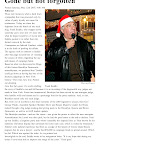


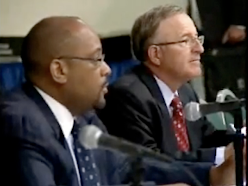
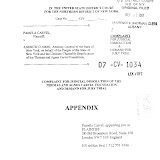


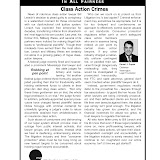

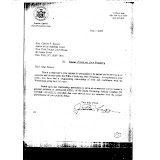
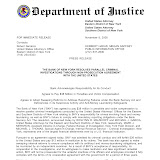
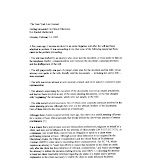

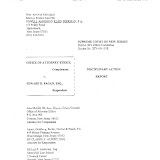
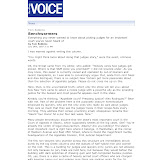

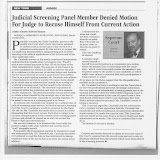



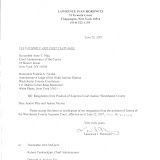
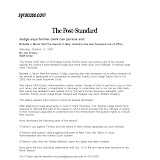
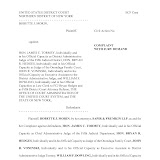

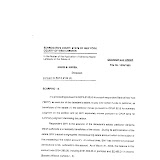
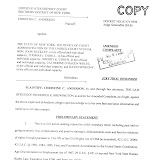
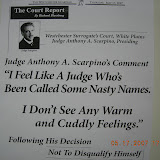
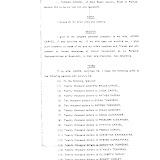
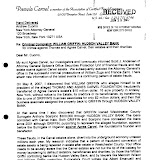
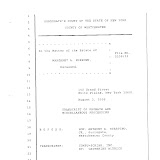
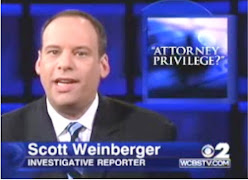
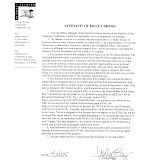
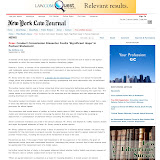
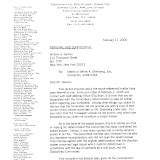
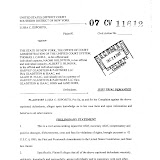
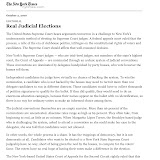
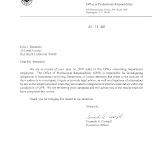
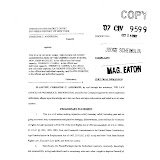
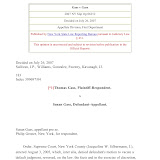
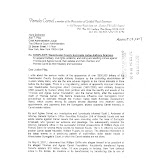

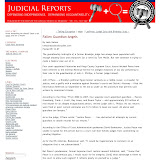
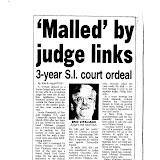
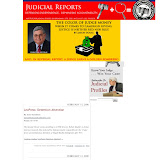
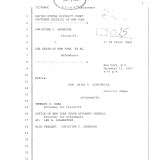
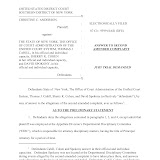
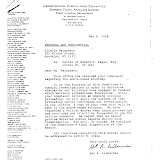
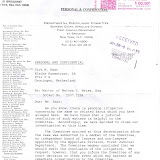
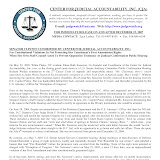


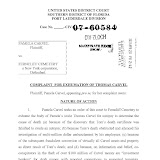
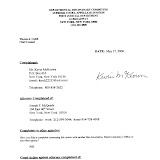
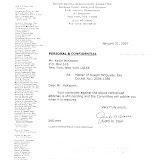
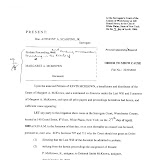
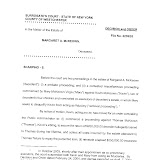
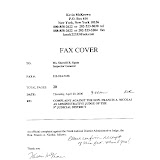

1 comment:
this low life fooled with union guys I say give him a beating and then cut the balls off this scumb*g now that would be big time JUSTICE
Post a Comment